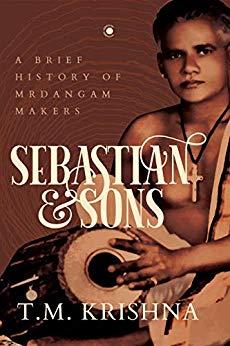
Read the full interview in the Deccan Herald >>
The writing in Sebastian and Sons introduces us to the storyteller in T M Krishna like never before. It’s a non-fictional work written with a novelist’s touch. It makes for a riveting read with the musician’s earnestness to absorb the stories of his subjects and his ability to look at the larger picture shining through. He concurs his approach was unique: “This book was very different writing for me; it was a new form for someone who has largely explored philosophical ideations driven by research (treatises), activism and self-introspection. This is the first time I wrote a book with the approach of a journalist. And it was other people’s stories, which I was trying to make sense of. I completely enjoyed the role of being an observer and a commentator.”
Source: Srivathsan Nadadhur, Deccan Herald, 7 June 2020
URL: https://www.deccanherald.com/sunday-herald/sunday-herald-art-culture/the-melody-of-dissent-an-interview-with-carnatic-vocalist-tm-krishna-845453.html
Date visited: 7 June 2020
Excerpt from S. Gopalakrishnan’s “Another Listening” newsletter
A much awaited book ‘Sebastian and Sons’ by TM Krishna on the evolution of the art of Mridangam making is going to be released on 2 February 2020. ‘The making process is an intellectually, aesthetically and physically taxing one. From acquiring the skins for the circular membranes and straps to the wood for the drum, from curing the material to the final construction, and at the end of it all, making sure that it has the tone that the mrdangam player wants, mrdangam-making is also a highly nuanced operation at every stage. This requires a highly tuned ear and an ability to translate abstract ideas expressed by musicians into the corporeal reality of a mrdangam. Yet, their contribution to the art of the mrdangam is dismissed as labour and repair—when it is spoken of at all.There are legendary mrdangam players, yes; there are also distinguished mrdangam makers, many of them from Dalit Christian communities, who remain on the fringes of the Karnatik community. Sebastian and Sons explores the world of these artists, their history, lore and lived experience to arrive at a more organic and holistic understanding of the music that the mrdangam makes’.
As a dedication to all major Mridangam makers of the past I dedicate Mridangam solos of three all-time masters, Pazhani Subramania Pillai, Palakkad Mani Iyer and Ramanathapuram C S Murugabhoopathy
1. Pazhani Subramania Pillai (1908-1962) : https://www.youtube.com/watch?v=8r2FafKt_X8
2. Palakkad Mani Iyer (1912-1981): https://www.youtube.com/watch?v=V9Zd8GjQ39w
3. Ramanathapuram CS Murugabhoopathy (1914-1998): https://www.youtube.com/watch?v=ZtFXE4aVMT8
Subscribe to the “Another Listening” newsletter for daily Carnatic music recommendations and more: anotherlistening@gmail.com
There is not only myth, but also vocabulary. “In Tamil, ‘thol’ means ‘skin’ and ‘thattu’ means ‘plate’. Mridangam players will talk about thattu, but not about thol,” Krishna said. “These were all ways of distancing.” […]
A problem had led Krishna to write this book in the first place.
“Failure drove me to the book,” he said. Because of his caste, among other things, he had been privileged all his life. That is one problem. […]
The mridangam is a paradox. The two-headed “king of percussion”, without which the sound of Carnatic music cannot be the same, is made of cowhide. Therefore the makers of the instrument have been traditionally Dalits or Dalit Christians, but its players and connoisseurs traditionally Brahmin and elite.
The history of the mridangam, as a result, has been a history of its erasure, for its users have tried to not see what it is. Krishna’s interest in his subject had a lot to do with his engagement with caste politics [*] and “the idea of the skin”.
Read “T.M. Krishna speaks about his new book, Sebastian and Sons at the Tata Steel Kolkata Literary Meet” (21 January 2020): https://www.telegraphindia.com/states/west-bengal/mridangam-the-cowhide-conundrum/cid/1739616
Some clarifications on caste-related issues by reputed scholars >>
T. M. Krishna (in MOPA “Notes to Myself”):
Now here is a fascinating story of a musician born and bred in privilege by his own admission, who enjoyed a liberal, progressive environment both at home and at school that laid the foundations for a fearless, critical mind and outspoken tongue, enjoyed the best of teachers who fostered an abiding love for Carnatic music in his young heart and was one among the band of young musicians who took the Carnatic stage by storm in the 90s. […]
Book search (India)
Websites sites covered here (Custom SafeSearch)
https://www.alephbookcompany.com
https://www.orientblackswan.com
Enter a book title, author’s name or any subject of special interest in the above search field.
Note: if the Google Custom Search window isn’t displayed on this page (on a tablet device and smartphone or any PC)
– “Enable JavaScript” in the “Security” settings of your internet browser
– Toggle to regular web view if you happen to use the “Reader” view
Audio tip | JA Jayanth’s grandfather and guru TS Sankaran live at Kalakshetra >>
Information about the persons, items or topics
Research & Custom search engines
The Oxford Illustrated Companion to South Indian Classical Music
Learn & practice more
A brief introduction to Carnatic music (with music examples and interactive map)
Bhava and Rasa explained by V. Premalatha
Free “flow” exercises on this website
Introduction (values in the light of modernity)
Video | Keeping tala with hand gestures: Adi (8 beats) & Misra chapu (7 beats)
Why Carnatic Music Matters More Than Ever
Worldcat.org book and journal search (including Open Access)